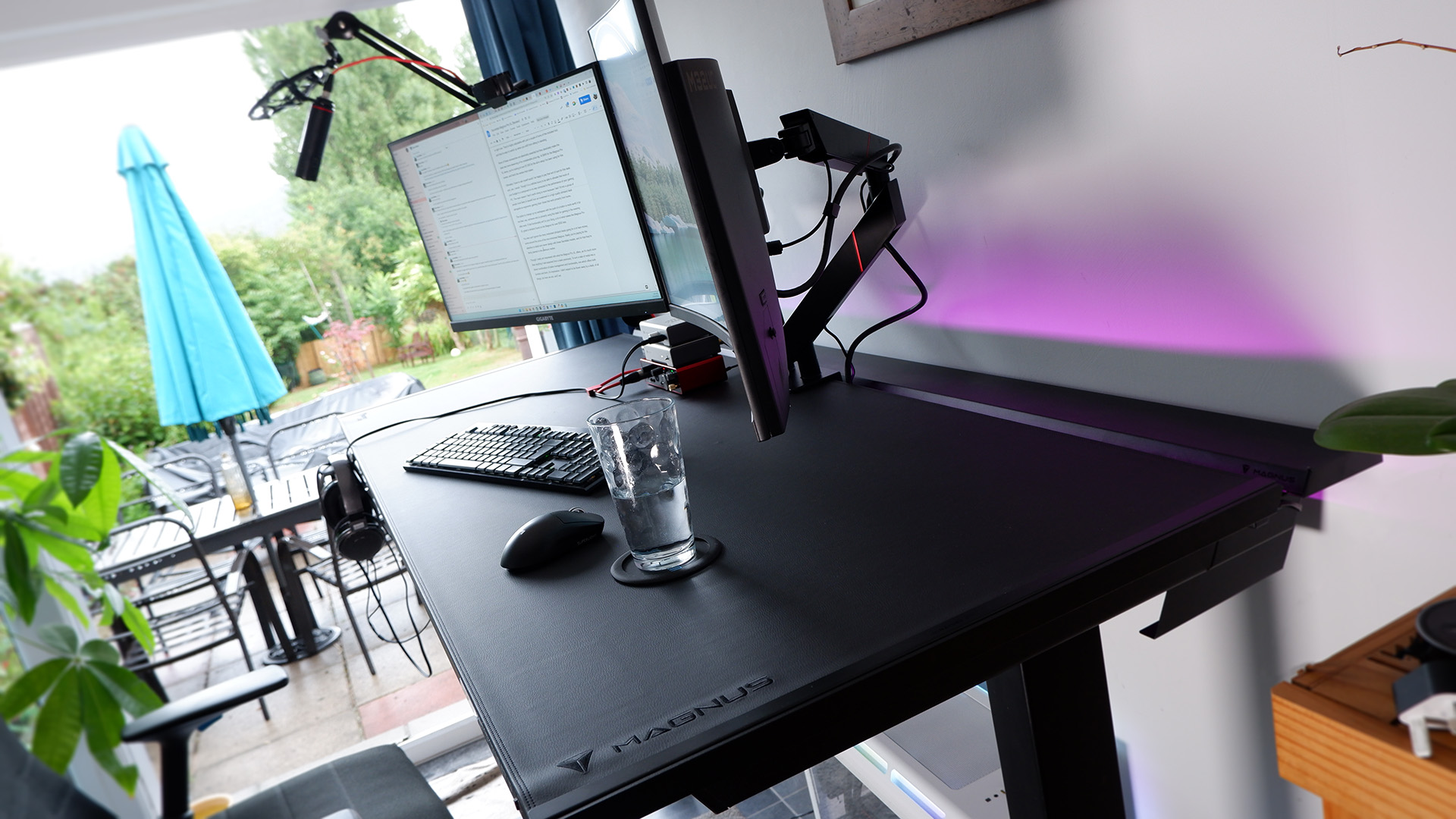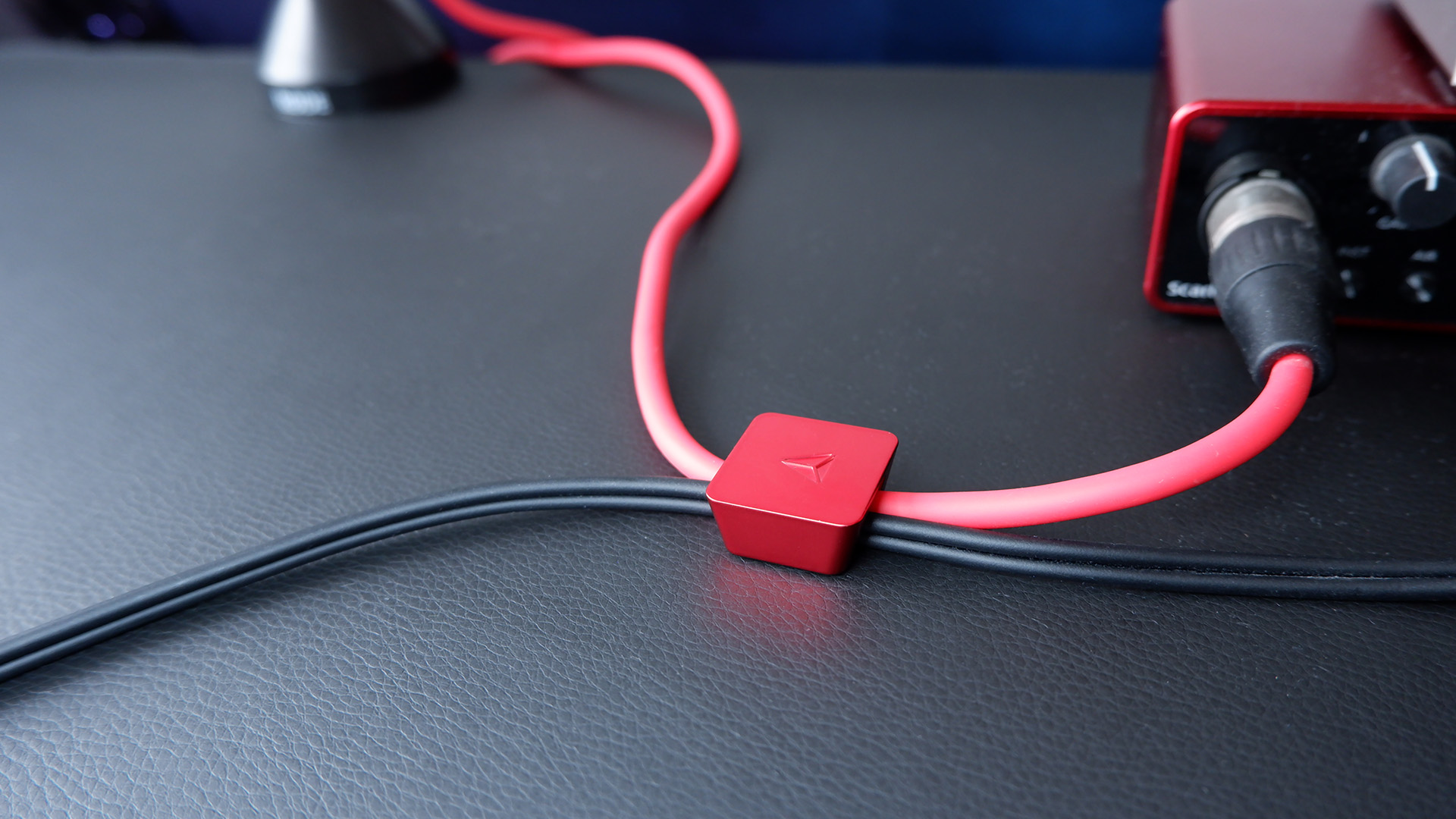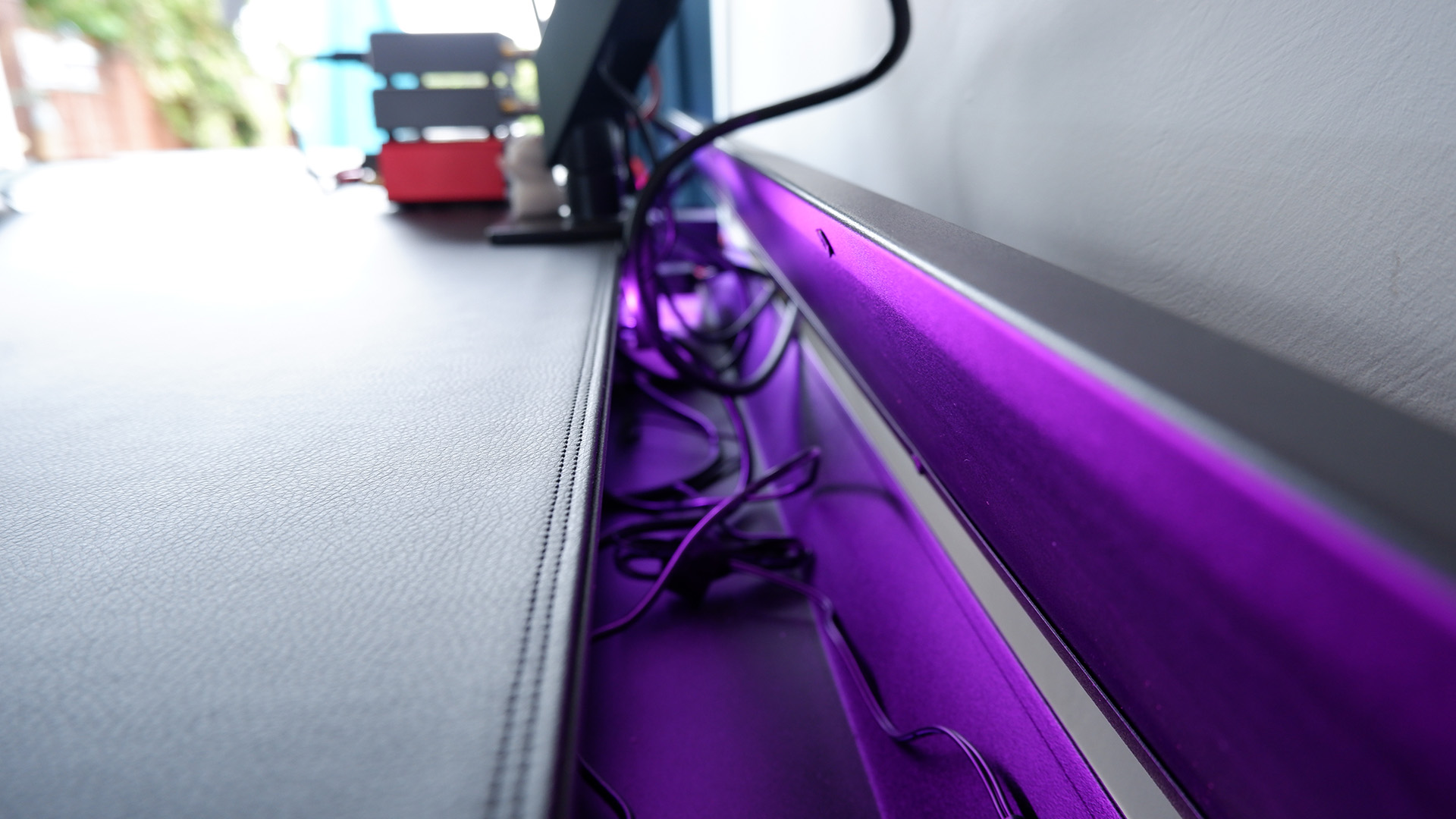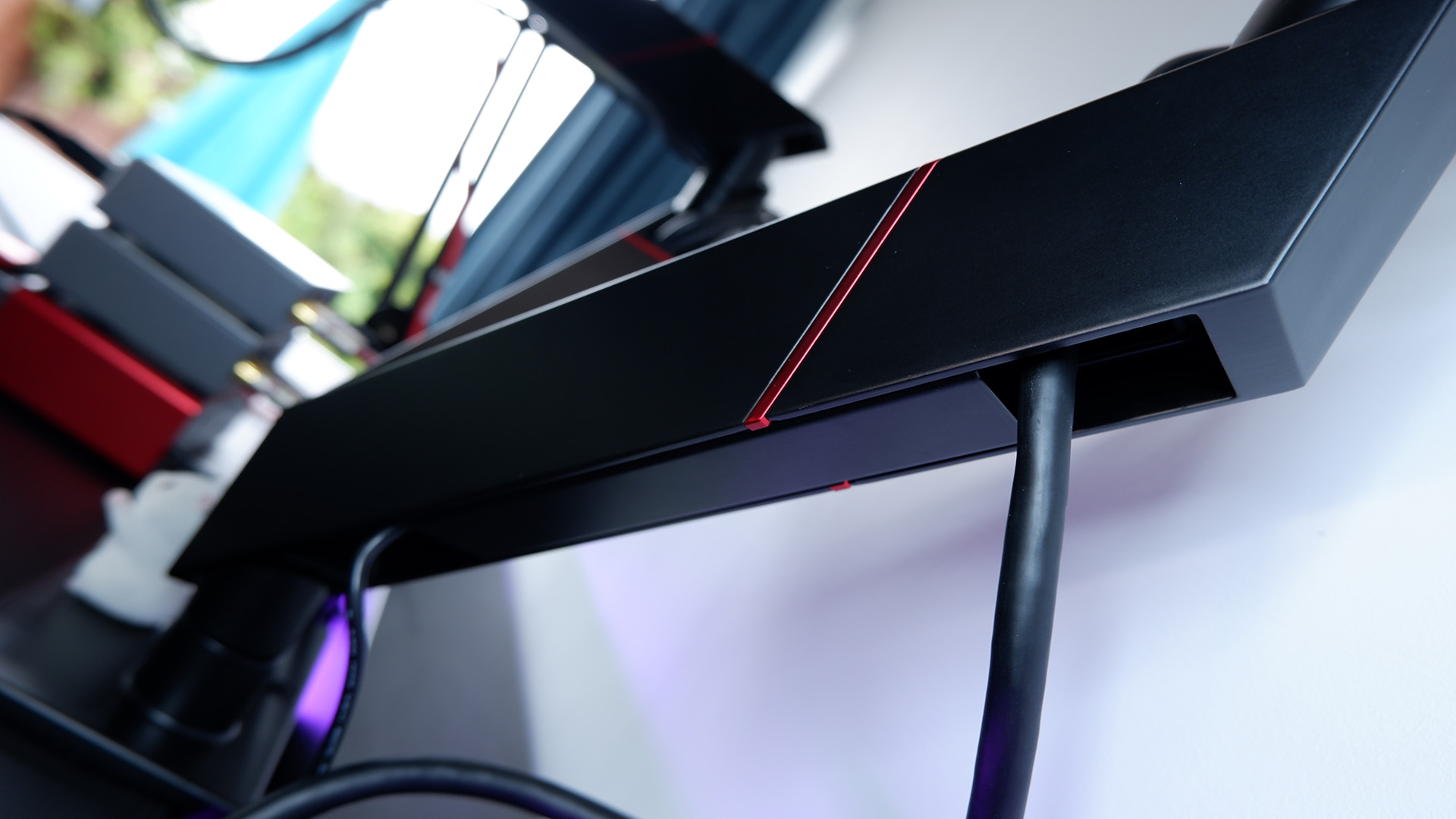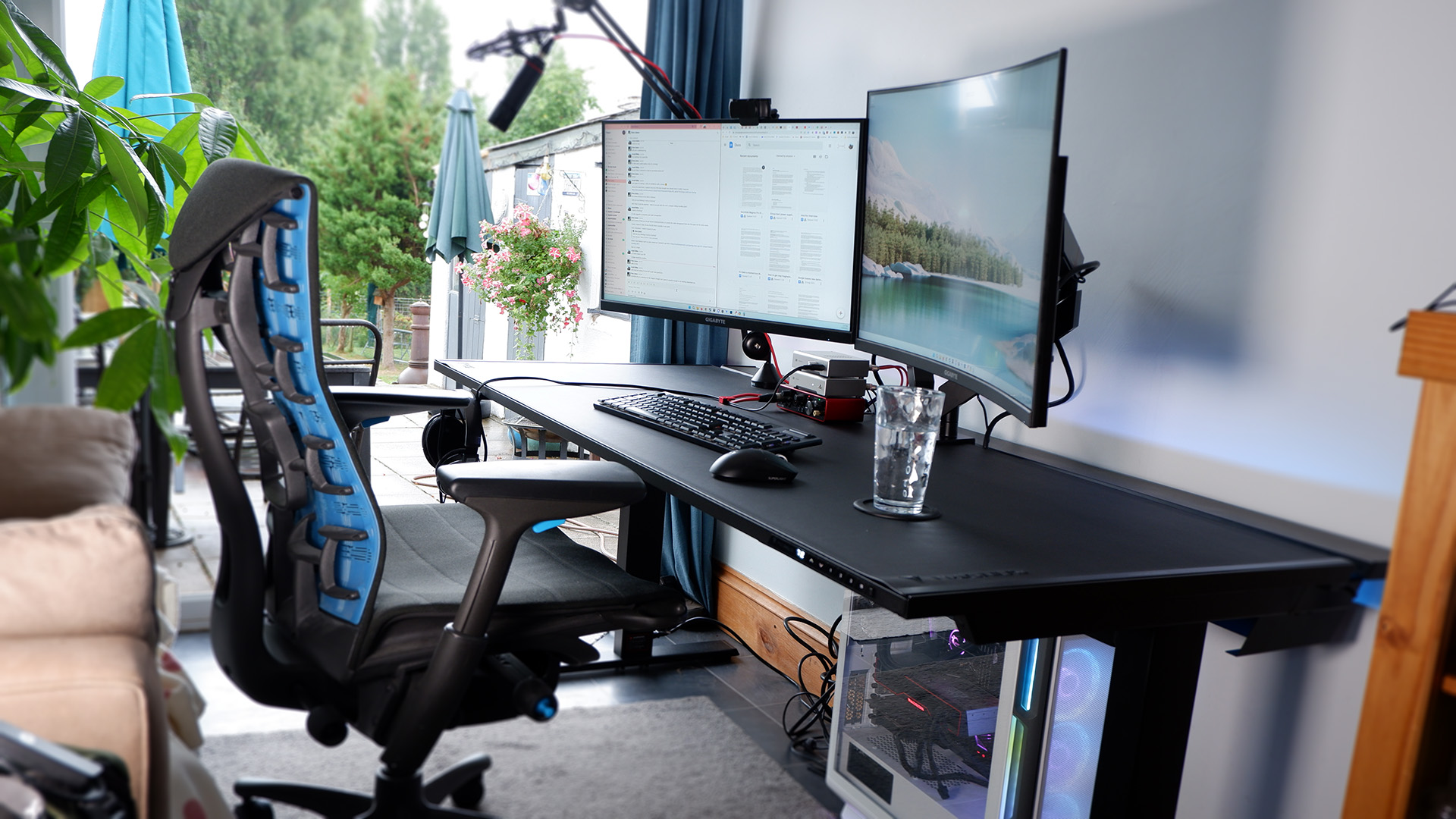Our Verdict
I've never known a gaming desk as genuinely impressive as the Magnus Pro XL. Every inch of it has been meticulously designed and it's as sleek to use as it looks. However, the Magnus Pro XL is also in the same realm as enthusiast graphics cards and OLED gaming monitors—absolutely fantastic but patently pricey for many.
For
- Fantastic for working from home
- Meticulously designed
- Smooth, easy-to-use sit/stand function
- Stealth cable management options
- Simple and effective magnetic accessories
- Excellent monitor arms (sold separately)
Against
- Weighs over 70kg
- Essential accessories add further cost
PC Gamer's got your back
Surprisingly innovative. That's how I'll sum up the Secretlab Magnus Pro XL. I've never been one to look for much in a gaming desk—I ask only for a flat plane on which to sit my monitors, keyboard, and mouse—yet the Magnus Pro XL has so thoroughly impressed me that I'm starting to reconsider my whole opinion of what a desk should be.
The sit/stand functionality on the Magnus Pro XL is quite simply one of the best out there.
I'm now firmly in the camp that a desk should be absolutely massive. The Magnus Pro XL is the largest desk I've ever used personally, having only recently found the space for such a behemoth, coming in at 177cm x 80cm. This is also the heaviest desk I've ever had to move solo by far, at 32.9kg for the desk alone. The mostly metal frame of the Magnus Pro XL, explains some of that, though it's the two included motors, one integrated into each of the legs, which add a whole lot of mass to the equation.
I don't have an exact weight for the completely assembled desk with accessories, but the two boxes the Magnus Pro XL comes in (which includes the Magpad Desk Mat but no other accessories) weigh ~77.8kg (171.5lb) combined.
But that's what makes this the Magnus Pro XL: the desk's adjustable sit/stand functionality. The standard Magnus doesn't offer this. The Magnus Pro XL is capable of lifting 120kg in gross weight (87.1kg if you subtract the weight of the metal desk itself) up to a height of 125cm. It sits only 65cm off the ground at its lowest.
Follow PC Gamer on TikTok for more tech and gaming videos.

Desk dimensions (including hinged tray cover): 177cm x 80cm x 2cm
Adjustable height range: 65–125cm
Weight: ~77.8kg
Warranty: 5 years
Accessories (included): Magpad Desk Mat
Accessories (not included): Cable Management Bundle ($49), PC Mount ($89), Dual Monitor Arm ($249), MagRGB Lighting Kit ($89), Headphone Hanger ($29)
Price: $949 | £829
To control the Magnus there's a control panel integrated into the front right of the desk. It's pretty easy to get to grips with. You can pre-program three heights to one of three hotkeys on the desk for quick adjustments or you can manually tap the up and down arrows for a little more granular control. The best bit, however, is the on/off switch, which simply prevents any accidental bum bumps or hand taps from moving the desk at all.
The sit/stand functionality on the Magnus Pro XL is quite simply one of the best out there. The motors are whisper quiet and they move with a liquid action. The fact they gradually come to a halt means you don't have to worry about what's on the desk jolting to a stop as you adjust it, even a cup of coffee or glass of water.
Keep up to date with the most important stories and the best deals, as picked by the PC Gamer team.
Another thing I've come to re-evaluate since the Magnus XL is how a desk should handle cable management. The foremost impressive thing about the Secretlab Magnus Pro XL is how sharp and clean-cut it makes your PC setup look. That's not through a lack of cables on my part, of which I have arguably too many, but for the Magnus Pro XL's clever magnetic cable management accessories and discrete cable tray. These hide my gluttony of USB, audio, and power cables out of sight.
My favourite of which is the compact cable tidy: a small block of metal with a couple of strong magnets within that securely fixes my cables in place. This has proven especially useful for my stack of audio devices, including DAC, amp, and microphone interface. Whereas the front-facing ports on these would usually spill the cables out towards my keyboard, I have neatly redirected these off to the side using only a single, magnetic cable tidy.
One unforeseen issue I ran into during my initial setup with this desk is that my mouse, the Logitech G Pro Wireless Superlight, was sticking to it. The Superlight has magnets in the base that are intended for use with Logitech's Powerplay charging system, and these magnets have some very slight sticking power to the Magnus Pro XL's metal surface. That causes a noticeable drag while you're skirting the desk's surface. My solution, however, was to remove the small plastic token from the underside of the Superlight, therefore keeping the magnets far enough away to avoid any sticky behaviour.
Though it must be noted that these magnetic cable ties are not included within the cost of the desk itself, and instead can be purchased for $25 for a set of three or for $49 as a set of three alongside two cable management sheaths and a stack of fastening straps. If, like me, you have plenty of velcro cable ties already, I'd recommend just picking up the three cable tidies on their own; the sheaths are decent, though may not be as handy depending on how you set up the desk with your PC.
This is the thing: the Secretlab Magnus Pro XL requires some added expense to make it as sleek an experience as it should be.
If you're tucking your PC under the desk you might want to consider extra lengthy DisplayPort, HDMI, or USB cables to make sure you have the length for the desk's sitting and standing positions. That's easier said than done, and I had to buy some new 3-metre DisplayPort and USB upstream cables to cope.
If that's not what you're after, you could mount your PC on the desk or consider Secretlab's PC Mount ($89), which hangs on the underside of the desk and offers a place to load your PC into. That means it can move up and down with the rest of the desk, cable runs be damned. My Corsair 5000T case rules that one out—the max load for the kit is 15kg and that case alone (sans any components) weighs 14.53kg.
The other extras to consider include the MagRGB Smart Lighting Edition lighting strip ($79) and the Magnetic Headphone Hanger ($29), which are slightly less essential, if quite appealing add-ons. I particularly like the robust, flexi-feel to the lighting strip, which is powered by Nanoleaf for in-sync RGB goodness. Though there is also a cheaper option I haven't tried out for $59.
The one accessory I really do think is worth investing in is the dual monitor arm. It's a single unit that clamps firmly onto the desk, between the hinged cover and the desk itself, and it offers sprawling reach for both the 28-inch and 32-inch monitors I've got in right now. They're highly adjustable with just a couple of turns of the included tool, and they're easy to switch up when you shift from sitting to standing. This accessory will set you back $249, however.
None of these accessories are absolutely essential but they absolutely make the desk feel more deserving of its considerable price tag. At $949 for the Magnus Pro XL alone, you're looking at over $1,000 for the all-in setup I've been using for this review, and that's the version that makes
Ultimately I have to ask myself would I be happy with this desk if I'd paid that sort of sum for it? And, yes, I would. Though it is a definite luxury to be able to allocate that much of your budget to a component in no way connected to the performance of your gaming PC. The main reason I feel it worth doing is more because I feel I fit into a group of people most likely to benefit from an investment in a high quality sit/stand desk alongside an ergonomic gaming chair: those that work primarily from home.
The option to change up my workspace with the push of a button is more worth it for me than, say, someone who is primarily using this desk for gaming in the evening after work. If that functionality isn't to your liking, a lot of what makes the Magnus Pro XL great is similarly found on the Magnus for over $350 less.
You also can't ignore the many motorised sit/stand desks going for a lot less money, some around the price of the non-motorised Magnus. Really you're paying for the attention to detail and clever design with these Secretlab models, and for that they're firmly planted in the premium market.
Though I really am impressed with what the Magnus Pro XL offers, as it's much more than anything I had expected from a desk previously. To turn a slab of metal into a clever combination of cable management and functionality, one which offers both function and form, it's impressive. I didn't expect to be blown away by a desk, of all things, but here we are, and I am.
I've never known a gaming desk as genuinely impressive as the Magnus Pro XL. Every inch of it has been meticulously designed and it's as sleek to use as it looks. However, the Magnus Pro XL is also in the same realm as enthusiast graphics cards and OLED gaming monitors—absolutely fantastic but patently pricey for many.

Jacob earned his first byline writing for his own tech blog, before graduating into breaking things professionally at PCGamesN. Now he's managing editor of the hardware team at PC Gamer, and you'll usually find him testing the latest components or building a gaming PC.
